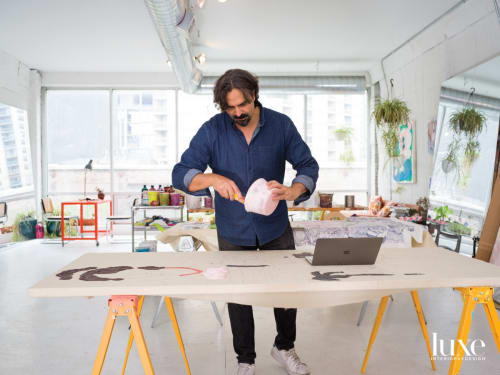José Lerma has a sense of humor. His paintings and drawings—be they renditions of historical figures or interpretations of The Last Supper—embody a cartoonish, tongue-in-cheek aesthetic, in spite of the pious originals that inspire them. “Often the content of what interests me is either very dry, or maybe sad or tragic,” he says. “So I try to give it a very happy, approachable, friendly aesthetic. The idea is that you could be a child and enjoy my works, but also as an adult for completely different reasons.”

"Portrait of Antonio Ulloa y de la Torre" and "Portrait of a Lady" are José Lerma's interpretations of anonymous works at the the Art Institute of Chicago.

Lerma's "Marxist Models" is part of a series that mixes deflated cliches of Latin American Guerrilla aesthetics with 1970s Italian fashion.

In his studio a study of Lerma's solo booth at Frieze NY, which was selected by El Museo del Barrio, sits next to wallpaper brushes, which he uses along with brooms to make the large brush marks on his work.

Lerma uses thick, bubblegum-esque paint to create his paintings.
Much of that whimsy comes from candy-like colors of the thick, bubblegum-esque paint he uses. Though it’s one of his signatures, the technique—which mixes pigments with construction materials and store-bought binders—was born out of necessity. “I started doing it when I was a student because it was cost-effective,” he admits. “But it also has the added benefit of being more connected to real life and to materials that exist all around us.”
Applying the paint in broad strokes using brooms and wallpaper brushes, Lerma meddles with perspective. “The idea is to enlarge the gesture as much as possible so that the work is not just big, but a small work made big, so that you feel smaller by extension and it puts you in a childlike state of mind.”
While his approach is lighthearted, the work is a broader examination of Latin representation in the art world. Lerma has created a series of what he calls “re-paintings” of Hispanic subjects in the European and American wings of the Art Institute of Chicago. “My goal was to speak of the lack of proportional representation for the Latin experience and sensibility in the American museum,” he explains.
Lerma’s new work-in-progress addresses the same concept. Creating doodles of the Art Institute’s European paintings on cocktail napkins, he photographs the napkins and will eventually digitally collage them into a much larger piece. “I have done all the European paintings in the west wing,” he says. “My goal is to finish all European paintings from the Renaissance to the impressionists.” Lerma will stack the pieces next to each other, following the curatorial logic of the museum. “The overall feeling of condensing and collapsing the images’ space is claustrophobic and optically charged,” he says. “It’s a caricature of a museum experience.”

